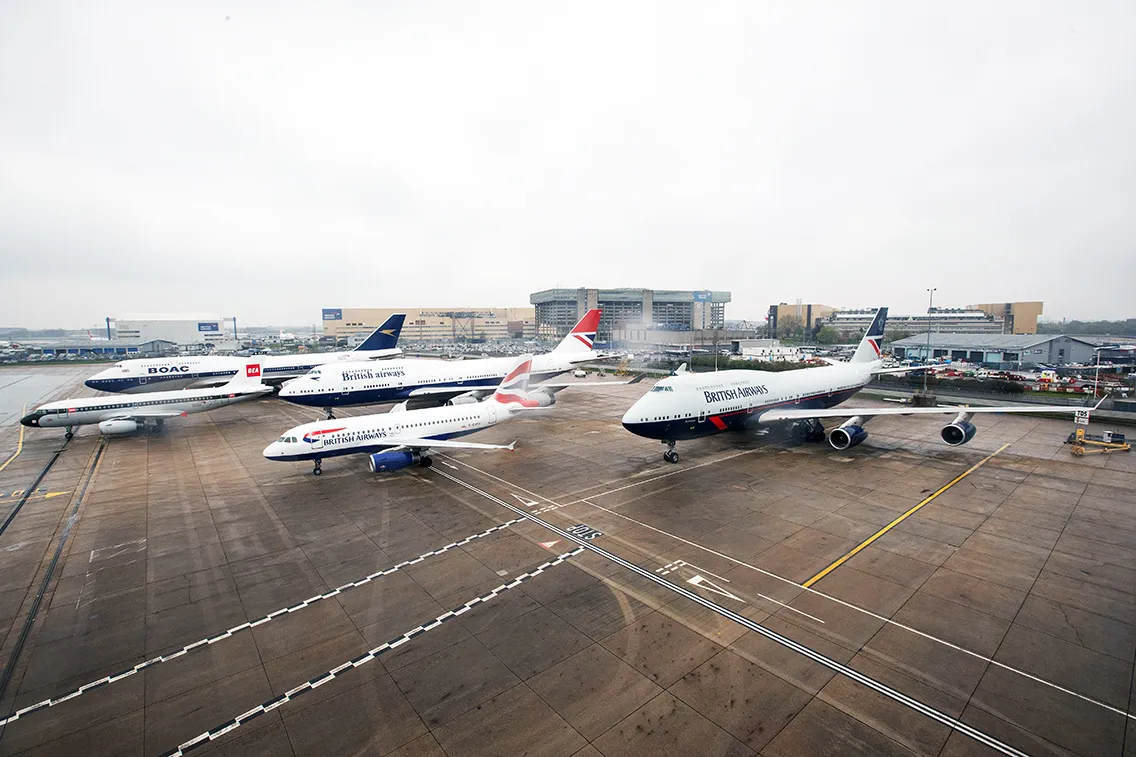
British Airways displays its retro fleet
Apr 10, 2019

British Airways recently showcased its retro fleet, celebrating the rich history of aviation while honoring its iconic designs. The airline featured aircraft adorned with vintage liveries that hark back to its earlier years, reflecting the evolution of air travel. This nostalgic display not only highlights the brand's heritage but also pays tribute to the pioneering spirit of the aviation industry. Enthusiasts and travelers alike marveled at the striking visuals, capturing the essence of a bygone era. The initiative serves as a reminder of British Airways' long-standing commitment to excellence in service and innovation throughout its history.
British Airways, a prominent name in the aviation industry, has recently showcased its retro fleet, highlighting the airline's rich heritage and commitment to nostalgia. The retro fleet features aircraft painted in the iconic liveries of the past, celebrating key moments in British Airways' history. This initiative not only attracts aviation enthusiasts but also serves as a marketing strategy that enhances brand recognition and customer loyalty. In this article, we will explore the significance of the retro fleet, the different aircraft involved, and how this aligns with current trends in the airline industry.
The Significance of the Retro Fleet
The retro fleet project is more than just a visual spectacle; it is a clever marketing strategy that taps into the emotional connections people have with air travel. By displaying aircraft in vintage liveries, British Airways evokes a sense of nostalgia, reminding passengers of the golden age of aviation. This initiative has proven to be a powerful tool for brand differentiation in a highly competitive market.
Additionally, the retro fleet enhances British Airways' visibility in social media and advertising campaigns. When passengers take photos of these beautifully restored aircraft, they share them online, creating organic content that further promotes the brand. This user-generated content is invaluable for British Airways as it enhances its online presence and engages a broader audience.
Key Aircraft in the Retro Fleet
The British Airways retro fleet includes several iconic aircraft, each representing a different era of the airline's history. Below is a table showcasing the key aircraft and their respective liveries:
| Aircraft Type | Livery | Era |
|---|---|---|
| Boeing 747-400 | Landor | 1984-1997 |
| Airbus A319 | Negus | 1974-1980 |
| Airbus A320 | Union Flag | 1997-2001 |
| Boeing 777-200 | British Overseas Airways Corporation (BOAC) | 1940s-1970s |
| Boeing 787-9 | British Airways | 2010s-Present |
Each aircraft tells a story and serves as a reminder of British Airways' legacy in the aviation sector. The Landor livery, for example, is particularly beloved among aviation fans, representing a time when the airline was expanding its international reach. The Negus livery harks back to the airline's commitment to modernity and innovation.
Marketing Strategies Around the Retro Fleet
British Airways has seamlessly integrated the retro fleet into its broader marketing strategies. The airline employs a multi-channel approach, utilizing social media, email newsletters, and traditional advertising to promote its retro aircraft. By doing so, British Airways capitalizes on the growing interest in vintage themes and experiences.
Moreover, the retro fleet has been featured in various promotional campaigns, including special flight offerings and merchandise. Passengers have the opportunity to book flights on these iconic aircraft, creating a unique travel experience that cannot be replicated. This exclusivity is a significant selling point, appealing to both loyal customers and new travelers seeking memorable experiences.
Customer Engagement and Experience
Engaging customers is crucial in today's airline industry, and the retro fleet serves as an effective tool in this regard. British Airways has hosted events and exhibitions where passengers can learn more about the history of the airline and its aircraft. Such initiatives foster a deeper connection between the airline and its customers, enhancing brand loyalty.
Furthermore, British Airways encourages passengers to share their experiences on social media using specific hashtags related to the retro fleet. This not only boosts the airline's online visibility but also creates a sense of community among aviation enthusiasts. The shared experiences of traveling on a retro aircraft become part of the airline's narrative, amplifying its brand story.
Conclusion
British Airways' retro fleet is a brilliant example of how an airline can leverage its history to foster customer engagement and enhance brand loyalty. By showcasing iconic aircraft in vintage liveries, the airline not only celebrates its past but also creates unique travel experiences for its passengers. As airlines continue to navigate a competitive landscape, innovative marketing strategies like the retro fleet will play a vital role in attracting and retaining customers.
In conclusion, British Airways stands out in the aviation industry by embracing nostalgia and connecting with travelers on an emotional level. The retro fleet is more than just a display of aircraft; it is a testament to the airline’s enduring legacy and commitment to delivering exceptional travel experiences.
Related Articles

Explore Thailand: The Best Islands to Visit for Paradise, Adventure, and Relaxation

The Ultimate Guide to the Best Islands in Thailand for Your Next Getaway

Do babies need passports? How to get a passport for a newborn

How to get a U.S. passport fast: here’s how to expedite the process

What is Mobile Passport Control: 5 reasons why you should use it

SENTRI vs. Global Entry: A detailed guide

Do you need a passport to go to the Bahamas? Let’s find out

Do you need a passport to go to Mexico? A detailed guide

Do you need a passport to go to Canada? We got the answer

Do You Need a Passport for a Cruise: An Essential Travel Guide

Booster Seat Requirements: All the Rules to Follow in Your Rental Car

What Are the World’s Most Powerful Passports, and How Does Yours Rank?

How to Take a Passport Photo at Home: A Helpful Guide

You've got to have heart! Southwest's new livery

Your opinion: Should water be free on low cost carriers?

Young women bolder than guys as solo travellers
